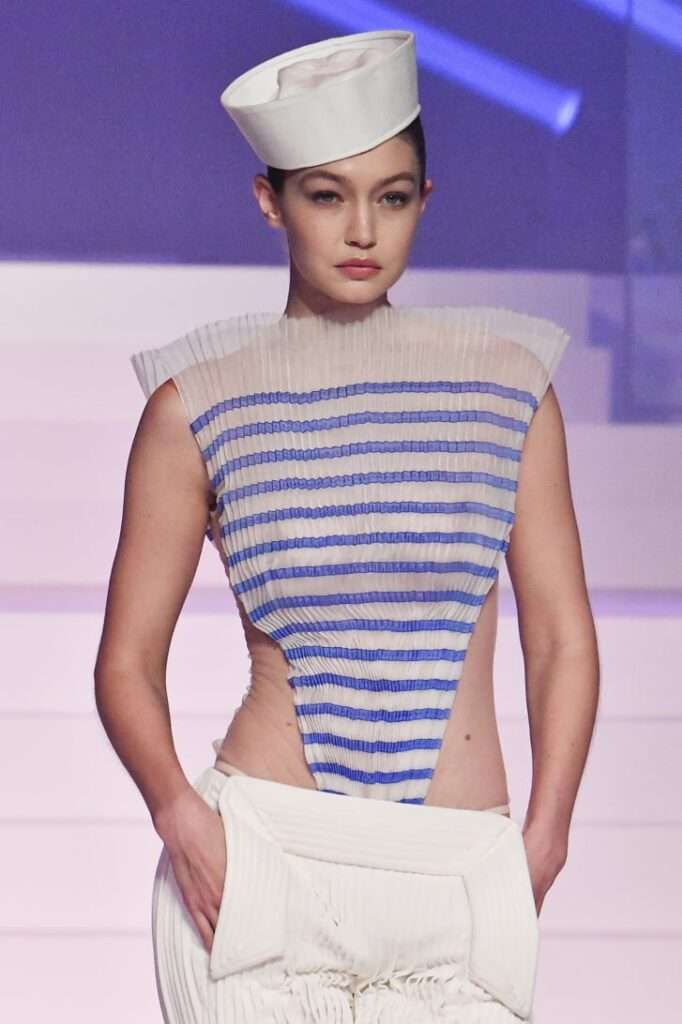
How nautical fashion captivated the world
The Britain’s Prince Louis dressed in a miniature sailor suit was one of the standout moments of the recent Platinum Jubilee celebrations. Nautical-inspired fashion has a long, varied history which has stood the test of time, and has endured as a trend loved by luxury and high street designers for decades.
“Nautical fashion enjoys lots of positive connotations: Of marine adventures and the romance of the sea,” Hannah Lyons, assistant curator of art at London’s National Maritime Museum, said via email. “It has an enduring appeal — it is timeless and ageless, and everyone can wear a nautical look.”
Nautical styles are both “practical but also visually appealing,” Lyons added. “I think it is this functionality combined with aesthetic appeal that makes it so inspirational to all designers — not just luxury ones.”
Royal beginnings: Queen Victoria to Empress Alexandra
When nautical fashion first started to go mainstream, Queen Victoria was one of its earliest pioneers. It began primarily with childrenswear, owing to the British monarch’s decision to commission a child-sized sailor suit for her son Prince Albert Edward in 1846.
Portraits of the 4-year-old prince in the outfit, who would become King Edward VII, would later be put on view to the public at St. James’s Palace, with the Royal Collection Trust stating more than 100,000 people would go on to view it. Lyons added the image was later “circulated in miniature, on enamel, on printed images, and later in photographs,” allowing it to reach an even bigger audience.
A description of the portrait on the Royal Collection Trust’s website read: “Its display helped stimulate a new fashion for children’s sailor suits and nautical leisurewear which would last for much of the century.”
At the time, the outfit was not only a fashion statement but also an example of soft power: A stylish show of support for Britain’s naval community. It would increase in popularity in the years to come, Lyons said. “Naval styles in British fashion were used to evoke a sense of national pride and solidarity with the Royal Navy during wartime, in particular during the First and Second World Wars.”
It wasn’t just in Britain. Empress Alexandra Feodorovna of Russia dressed her young son Tsesarevich Alexei in the style for a photograph in 1913. And in Japan, amidst a period of rapid modernization as it sought to leave the Meiji era behind, Japanese schools latched onto European sailor-suits as inspiration for new female uniforms known as “seifuku” around the 1920s. While male school uniforms inspired by the Japanese naval attire had been around since 1879, female Meiji era uniforms had largely been inspired by traditional hakama clothing — wide-legged pleated trousers, worn high on one’s waist.
Namba Tomoko, an associate professor at Tokyo’s Ochanomizu University, said in a 2018 Nippon article: “Female school uniforms began to change in the 1920s, with Western-style clothing increasingly becoming the norm. Many students at the time enthusiastically welcomed sailor suits, helping establish the look as the standard uniform.”

In time, nautical fashion’s association with naval power would begin to shift as more international designers entered the scene.
The Breton top becomes a French navy staple — and Coco Chanel’s
Beyond British naval influences, the French navy’s striped uniform also began to have an impact internationally. In 1858, the French navy introduced the striped tricot rayé — otherwise known as the “mariniere” or Breton top — as part of standard uniform. According to French brand Saint James, which has been creating Breton tops since 1889, a naval decree dictated the top would have 21 white stripes and 20 to 21 indigo blue stripes.
Although the reason behind the exact number of stripes isn’t known, Saint James claims a popular theory is that “21 stripes (correspond) to the number of Napoleonic victories” while another is that the striking pattern was instantly visible should someone fall overboard.
Beyond French naval officers, the sight of fishermen wearing what would become known as the Breton top would become increasingly commonplace in Normandy and Brittany. As they sailed between France and England to hawk their wares, the item grew in recognition as French holidaymakers along the Riviera began to adopt the Breton top as part of their wardrobe.
Lyons explained it would grow to be “associated with the bohemian life by the sea,” bringing romance to the style especially as it spread in popularity.

According to Royal Museums Greenwich, the Breton top would find international fame thanks to a couple of influential American expatriates named Gerald and Sara Murphy. While visiting American composer Cole Porter on the French Riviera in 1922, they would purchase tricot rayés for their famous friends including Ernest Hemingway, F. Scott and Zelda Fitzgerald, elevating the top’s profile as the trendsetters showcased them to the American public.
In France, designer Coco Chanel championed the style in the 1930s — true to her groundbreaking approach to women’s fashion, which incorporated menswear elements and pushed the boundaries. Lyons said: “Chanel transformed the striped ‘Breton’ into a bohemian look — more about the romance of the sea than its associations with the navy.”
“It helped that public figures such as James Dean and Audrey Hepburn adopted the Breton, thus increasing its popularity even further and associating it with the glamour of Hollywood,” she added.
Modern nautical styles: From the 1960s to today
Later in the 20th century, more luxury designers began to draw on nautical styles for their collections. Yves Saint Laurent took the Breton top and made it glamorous in 1966 – transforming it into a floor-length evening gown, with its iconic stripes realized in dazzling sequins.
And Jean Paul-Gaultier, who wore Breton tops in his youth in Paris, would incorporate the stripes into his 1984 “Boy Toy” collection, sparking a lifelong love affair with “mariniere” for the designer. Nautical styles would return in his 1996 “Pin-Up Boys” collection, the following year’s “Russia” and “Salon Atmosphere” collections and continues to this day with Gigi Hadid modeling a sailor hat and daring pleated version of the Breton striped top at Gaultier’s Spring/Summer 2020 Haute Couture show.
In the exhibition catalog of “The Fashion World of Jean Paul-Gaultier,” Gaultier said of a backless 1984 piece: “I reinterpreted the sailor-striped sweater by giving it an open back, which was considered disrespectful!”

In recent years, the vintage charm of nautical fashion has also been renewed with brands such as Zimmermann and Ghost reintroducing sailor collar silhouettes into their looks. Last year’s cottagecore — one of fashion’s biggest trends inspired by bohemian pastoral lifestyles — also fully embraced sailor collars, adding an old world feel to floral gowns and puff-sleeve tops.
Nautical has also remained a mainstay of the royal family’s wardrobe, from a young Prince William to his future wife Catherine, Duchess of Cambridge and his late mother Princess Diana. Princess Diana, in particular, favored sailor collars — wearing one during a trip to visit the Royal Naval College in 1989.

“Quite simply, nautical fashion is less concerned with the navy and war and now more associated with leisure, pleasure and good taste,” Lyons said.

Magazine launched for helping women for success. Lakkars has always served and worked efficiently towards women empowerment, we have blossomed into America’s most-read fashion magazine.


